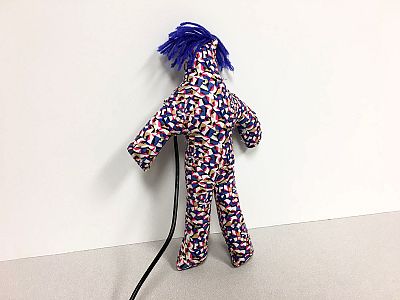The masochistic little bots are intended to help people process negative emotions, but some experts wonder if they might do just the opposite.
It's no secret that technology can drive us batty. Between glitchy apps, social media outages and data breaches, the only thing stopping some people from smashing their personal tech is the exorbitant cost of replacing it.
Now a trio of researchers say they've found a way to use technology to channel our rage rather than provoke it. They've created robots designed not to perform tasks but to serve as our personal punching bags.
The research team, based at Carnegie Mellon University in Pittsburgh, says the so-called "cathartic objects" are designed to be hit, stabbed, cursed and otherwise abused. The bots don't complain or fight back, as seen in a video, but they do respond by flashing lights and flailing around.
Why should we take our anger out on robots? The researchers say it's all about catharsis, the process by which people give full expression of their negative emotions as a way to curb them.
"Negative emotions are unpleasant, but they are necessary," Michal Luria, a doctoral student in human-computer interaction at the university and leader of the team who created the robots, told NBC News MACH in an email. "I suggest that technology can help us channel our negative emotions in a healthier way, that doesn't hurt the people around us."
Luria and her colleagues created four different prototype robots.
Object 1 is a moplike robot covered in black fabric that wiggles back and forth when poked with something sharp.
Object 2 is a blocky geometric shape that emits a glowing red light when it hears swear words (see image at top).
Object 3, the most humanlike, has a doll-like fabric body and a shock of blue hair. It provokes users with an irritating laugh until they pound it into submission.
Object 4 is a yellow plastic cartridge lined with LED lights that allows users to write what's irritating them on a ceramic tile and then safely pulverize it with a hammer. Users can keep the shattered tile as a reminder of both the negative emotions and the smashing good time that relieved them.
If hauling off and hitting a helpless robot sounds as if it might encourage our sadistic tendencies, Luria says it's just the opposite. In a paper describing the team's research, which was presented May 5 at a human computer interaction conference in Glasgow, Scotland, she and her co-authors cite research linking expressions of anger to higher pain tolerance and better responses to being wronged.
"Catharsis has been controversial since its early days," Luria told IEEE Spectrum. "But recently, researchers have been finding that physical expression of anger in particular contexts or combined with reflection can be beneficial."
But Patrick Markey, a professor of psychological and brain sciences at Villanova University, isn't so sure. In an email to NBC News MACH, he called catharsis an outdated concept, adding that beating up a robot might make us feel more angry, not less.
"As a psychologist, there is nothing I would like better than the idea that you could reduce a person's negative emotions by having them hit a robot," he said. "However, it seems extremely unlikely this will actually have any real effect on reducing anger."
Sarita Robinson, a psychology lecturer at the University of Central Lancashire in Preston, England, agreed with Luria that physical expressions of anger can be beneficial for some. But she said stabbing a robot that appears to quiver in pain could be a distressing experience, particularly for those who tend to humanize nonliving objects.
"People can start to believe that their car has a personality and will give it a name, or that their kettle is sad when it gets broken," she said in an email. "If people start to attribute thoughts and feelings to the cathartic robots, then they might not be able to bring themselves to hurt them."
The researchers acknowledged that, for now, it's hard to gauge the effectiveness of robot-assisted catharsis. In the paper, they argue that it would be hard to obtain institutional approval for a study with participants angry enough to assault their computer hardware.
Instead, Luria said she'd use herself as a test subject, interacting with a prototype at home and carefully documenting the results. If the first test goes well, Luria said, she'd try the bots out on others, too.
Robinson, the psychology professor, has a different idea for the future of these punching bag bots. "Maybe in the future," she joked, "cathartic robots will need to be customized so that they resemble your boss."
Want more stories about technology?
- Solar farms in space could be renewable energy's next frontier
- Biometric scanning at airports is spreading fast, but some fear the face-scanning systems
- Mood-forecasting tech could help stop bad moods even before they strike
SIGN UP FOR THE MACH NEWSLETTER AND FOLLOW NBC NEWS MACH ON TWITTER, FACEBOOK, AND INSTAGRAM.














